A worm X found in freshwater and slow-moving streams has been accidently cut into three pieces. It was observed that in due course of time, each cut piece of the worm develops to become a complete worm by growing all the missing parts.
Can a dog be produced completely from its cut body part (say, a cut tail) just like organisms X and Y? Why?
Step by step video & image solution for A worm X found in freshwater and slow-moving streams has been accidently cut into three pieces. It was observed that in due course of time, each cut piece of the worm develops to become a complete worm by growing all the missing parts. Can a dog be produced completely from its cut body part (say, a cut tail) just like organisms X and Y? Why? by Biology experts to help you in doubts & scoring excellent marks in Class 10 exams.
Updated on:21/07/2023Topper's Solved these Questions
- HOW DO ORGANISM REPRODUCEBOOK - BETOPPERSCHAPTER - HOW DO ORGANISM REPRODUCEEXERCISE - WORKSHEET 2
35 Videos
- HOW DO ORGANISM REPRODUCEBOOK - BETOPPERSCHAPTER - HOW DO ORGANISM REPRODUCEEXERCISE - WORKSHEET 3
67 Videos
- HEREDITY & EVOLUTIONBOOK - BETOPPERSCHAPTER - HEREDITY & EVOLUTIONEXERCISE - COMPETITIVE WORKSHEET
34 Videos
- LIFE PROCESSESBOOK - BETOPPERSCHAPTER - LIFE PROCESSESEXERCISE - COMPETITIVE WORKSHEET
82 Videos
Similar Questions
A worm X found in freshwater and slow -moving streams has been accidentally cut into three pieces. It was observed that in due course of time, each cut piece of the worm develops to become a complete worm by growing all the missing parts.
(a) Name the worm X which can exhibit this phenomenon of making complete worm from its cut body parts.
(b) Name another organism Y which possesses the same characteristic of growing full its cut body parts.
(c) What is the name of this process in which a complete organism is formed from its cut body part.
(d) State whether X and Y are unicellular and / or multicellular organisms .
(e) Can a dog be produced completely from its cut body part (say, a cut tail) just like organisms X and Y? Why?
View SolutionA filamentous alga X is found is ponds, lakes and slow-moving steams. The filament of this alga simply breaks onto two (or more) pieces on maturing and each piece then grows to becomes a complete new alga.
(a) Name on alga which X is likely to be.
(b) What is the colour of X ?
(c) What is the method of forming new algae by the breaking of parent alga known as ?
(d) An Amoeba also breaks up to from two daughter Amoeba. What is the difference in splitting of Amoeba and splitting of this alga as a method of reproduction?
(e) Name one marine animal which reproduces in the same way as alga X
View Solution
Knowledge Check
Two independent light sources are always incoherent. This is because phase of light emitted is random and phase difference, at any point, changes very rapidly with time. So as to obtain observable interference, we require coherent sources which emit light of same wavelength such that phase difference at any point does not change with time. In different interference experiments, the method to obtain two coherent sources could be different. In Fresnel's biprism experiment, two virtual images of a real source, which are formed due to refraction at the biprism, act as coherent source. In Lloyd’s mirror experiment, a real source and its virtual image formed due to reflection at a plane mirror act as coherent source. Two images of a source or a source and its image are coherent because of their phase correlation. It is also possible to obtain coherent sources by forming two images of a point source in the following manner.As shown in the figure, S is a monochromatic point source. A thin circular lens is cut into two identical halves L, and L2 by a plane passing through a diameter. L1 is kept above the axis and L2 below it is in a symmetrical manner such that the gap between the two is 0.1 mm. Each forms an image Qf the source and the two images, say, Si and S2 , act as coherent sources. Superposition of waves from these coherent sources will result in observable interference and a pattern can be obtained on a screen.The lens which has been cut to from L, and L2 is made of a material of refractive index 1.5 for the wavelength emitted by the source S. Radius of curvature of each surface of the lens is 18 cm. Source S is 30 cm along the axis fro Li and L2 . It is found that smallest distance from O along the screen at which intensity is half of the maximum intensity is 0.1 mm. It is also observed that the highest order of maximum intensity in the interference patter is 416.
Q Distance of a point from O, at which the sixth order minimum is formed, will be
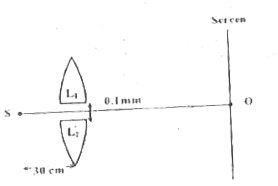 A1.4 mmB1.8 mmC1.8 mmD2.2 mm
A1.4 mmB1.8 mmC1.8 mmD2.2 mmTwo independent light sources are always incoherent. This is because phase of light emitted is random and phase difference, at any point, changes very rapidly with time. So as to obtain observable interference, we require coherent sources which emit light of same wavelength such that phase difference at any point does not change with time. In different interference experiments, the method to obtain two coherent sources could be different. In Fresnel's biprism experiment, two virtual images of a real source, which are formed due to refraction at the biprism, act as coherent source. In Lloyd’s mirror experiment, a real source and its virtual image formed due to reflection at a plane mirror act as coherent source. Two images of a source or a source and its image are coherent because of their phase correlation. It is also possible to obtain coherent sources by forming two images of a point source in the following manner.As shown in the figure, S is a monochromatic point source. A thin circular lens is cut into two identical halves L, and L2 by a plane passing through a diameter. L1 is kept above the axis and L2 below it is in a symmetrical manner such that the gap between the two is 0.1 mm. Each forms an image Qf the source and the two images, say, Si and S2 , act as coherent sources. Superposition of waves from these coherent sources will result in observable interference and a pattern can be obtained on a screen.The lens which has been cut to from L, and L2 is made of a material of refractive index 1.5 for the wavelength emitted by the source S. Radius of curvature of each surface of the lens is 18 cm. Source S is 30 cm along the axis fro Li and L2 . It is found that smallest distance from O along the screen at which intensity is half of the maximum intensity is 0.1 mm. It is also observed that the highest order of maximum intensity in the interference patter is 416.
Q Phase difference between the light waves 0.1 mm from along the screen, where intensity is half the maximum value, is
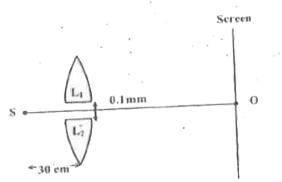 A) tt/2Bk/3Ctt/4Dir/6
A) tt/2Bk/3Ctt/4Dir/6Two independent light sources are always incoherent. This is because phase of light emitted is random and phase difference, at any point, changes very rapidly with time. So as to obtain observable interference, we require coherent sources which emit light of same wavelength such that phase difference at any point does not change with time. In different interference experiments, the method to obtain two coherent sources could be different. In Fresnel's biprism experiment, two virtual images of a real source, which are formed due to refraction at the biprism, act as coherent source. In Lloyd’s mirror experiment, a real source and its virtual image formed due to reflection at a plane mirror act as coherent source. Two images of a source or a source and its image are coherent because of their phase correlation. It is also possible to obtain coherent sources by forming two images of a point source in the following manner.As shown in the figure, S is a monochromatic point source. A thin circular lens is cut into two identical halves L, and L2 by a plane passing through a diameter. L1 is kept above the axis and L2 below it is in a symmetrical manner such that the gap between the two is 0.1 mm. Each forms an image Qf the source and the two images, say, Si and S2 , act as coherent sources. Superposition of waves from these coherent sources will result in observable interference and a pattern can be obtained on a screen.The lens which has been cut to from L, and L2 is made of a material of refractive index 1.5 for the wavelength emitted by the source S. Radius of curvature of each surface of the lens is 18 cm. Source S is 30 cm along the axis fro Li and L2 . It is found that smallest distance from O along the screen at which intensity is half of the maximum intensity is 0.1 mm. It is also observed that the highest order of maximum intensity in the interference patter is 416.
Q0.25 mm
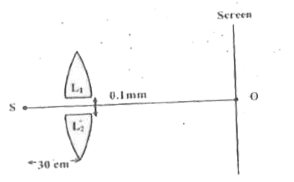 A7200 ÅB6000ÅC5500ÅD4200Å
A7200 ÅB6000ÅC5500ÅD4200Å
Draw diagrams to explain the regeneration that takes place in each of the body parts of Planaria when its body is cut into three pieces. Name any other organisms in which a similar process can be observed.
View SolutionTwo independent light sources are always incoherent. This is because phase of light emitted is random and phase difference, at any point, changes very rapidly with time. So as to obtain observable interference, we require coherent sources which emit light of same wavelength such that phase difference at any point does not change with time. In different interference experiments, the method to obtain two coherent sources could be different. In Fresnel's biprism experiment, two virtual images of a real source, which are formed due to refraction at the biprism, act as coherent source. In Lloyd’s mirror experiment, a real source and its virtual image formed due to reflection at a plane mirror act as coherent source. Two images of a source or a source and its image are coherent because of their phase correlation. It is also possible to obtain coherent sources by forming two images of a point source in the following manner.As shown in the figure, S is a monochromatic point source. A thin circular lens is cut into two identical halves L, and L2 by a plane passing through a diameter. L1 is kept above the axis and L2 below it is in a symmetrical manner such that the gap between the two is 0.1 mm. Each forms an image Qf the source and the two images, say, Si and S2 , act as coherent sources. Superposition of waves from these coherent sources will result in observable interference and a pattern can be obtained on a screen.The lens which has been cut to from L, and L2 is made of a material of refractive index 1.5 for the wavelength emitted by the source S. Radius of curvature of each surface of the lens is 18 cm. Source S is 30 cm along the axis fro Li and L2 . It is found that smallest distance from O along the screen at which intensity is half of the maximum intensity is 0.1 mm. It is also observed that the highest order of maximum intensity in the interference patter is 416.
QDistance between the images Si and S2 will be
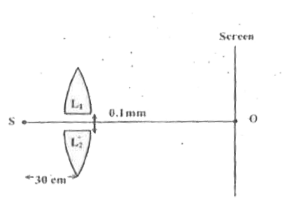
View SolutionTwo independent light sources are always incoherent. This is because phase of light emitted is random and phase difference, at any point, changes very rapidly with time. So as to obtain observable interference, we require coherent sources which emit light of same wavelength such that phase difference at any point does not change with time. In different interference experiments, the method to obtain two coherent sources could be different. In Fresnel's biprism experiment, two virtual images of a real source, which are formed due to refraction at the biprism, act as coherent source. In Lloyd’s mirror experiment, a real source and its virtual image formed due to reflection at a plane mirror act as coherent source. Two images of a source or a source and its image are coherent because of their phase correlation. It is also possible to obtain coherent sources by forming two images of a point source in the following manner.As shown in the figure, S is a monochromatic point source. A thin circular lens is cut into two identical halves L, and L2 by a plane passing through a diameter. L1 is kept above the axis and L2 below it is in a symmetrical manner such that the gap between the two is 0.1 mm. Each forms an image Qf the source and the two images, say, Si and S2 , act as coherent sources. Superposition of waves from these coherent sources will result in observable interference and a pattern can be obtained on a screen.The lens which has been cut to from L, and L2 is made of a material of refractive index 1.5 for the wavelength emitted by the source S. Radius of curvature of each surface of the lens is 18 cm. Source S is 30 cm along the axis fro Li and L2 . It is found that smallest distance from O along the screen at which intensity is half of the maximum intensity is 0.1 mm. It is also observed that the highest order of maximum intensity in the interference patter is 416.
Q Fringe width is nearly
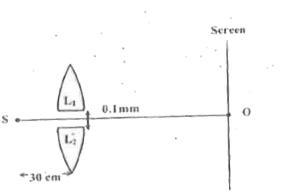
View SolutionRead the passage carefully and answer the question given below:
Who would have thought that every squeal, squeak and chirp that comes out of the mouth of the humble Gunnison Prairie dog means something ? A three-decade study of these rodents has revealed a language so complex, that is surpasses the communication skills of dolphins, whales and even non-human primates like monkeys!
The stunning findings were revealed by Professor Con Slobodchikoff, who has been recording
The smart little rodents use their words to identify not only who the predator is, i.e. a coyote , human , dog, or a particular kind of bird, but also details like their shape, size color and even the pace at which they are approaching.
To conduct his research, the professor and a number of students from Northern Arizona University, hid inside the prairie dog villages and recorded all the sounds they made. What the team discovered is that these smart creatures are able alert their entire group of many details, (the predator, its color, location, etc.) by sounding just one single 'word'. They do that by modulating or varying the pitch of their voice.
What was also interesting is how the animals responded to each kind of predator. In the case of a coyote, they quickly scampered into their burrows, while for badgers, they simply laid low, to avoid being spotted.
To test their theories, the scientist played back some of the recorded sounds, as well as, asked four volunteers to walk into the prairie village, wearing a different coloured shirt each time, the rodents reacted exactly the same way they had in the presence of the real predator, confirming that the animal had not only conveyed that the predator was a human, but also, whether he/she was fat/thin and the color of the shirt ! Simple fascinating!
While dubbed dogs, thanks to their canine-like barks, Prairie dogs are actually ground dwelling squirrels and part of the rodent family, which includes not only rats and mice, but also, porcupines and beavers. The Gunnison, found primarily in North America, is one of five species that is alive today.
By Meera Dolasia
Question : In the passage, the writer say that these animals were "dubbed dogs" because they:
View SolutionComprehension:
Read the passage and answer the questions that follow.
The methods of embalming, or treating the dead body, that the ancient Egyptians used is called 'mummification'. Using special processes, the Egyptians removed all moisture from the body, leaving only a dried form that would not easily decay. It was important in their religion to preserve the dead body in as life like a manner as possible. The mummification process took seventy days. Special priests worked as embalmers, treating and wrapping the body, Beyond knowing the correct rituals and prayers to be performed at various stages, the priests also needed a detailed knowledge of human anatomy. The first step in the process was the removal of all internal parts that might decay rapidly. The brain was removed by carefully inserting special hooked instruments up through the nostrils in order to pull out bits of brain tissue. The embalmers then removed the organs of the abdomen and chest through a cut usually made on the left side of the abdomen. They left only the heart in place, believing it to be the center of a person's being and intelligence, The other organs were preserved separately, with the stomach, liver, lungs and intestines placed in special boxes or jars, today called 'canopic jars'. These were buried with the mummy. The embalmers next removed all moisture from the body. This they did by covering the body with 'natron', a type of salt which has great drying properties, and by placing additional natron packets inside the body. When the body had dried out completely, embalmers removed the internal packets and lightly washed the natron off the body. The result was a very dried-out but recognizable human form. To make the mummy seem even more life like, sunken areas of the body were filled out with linen and other materials and false eyes were added. Next the wrapping began. Each mummy needed hundreds of yards of linen. The priests carefully wound the long strips of linen around the body, sometimes even wrapping each finger and toe separately before wrapping the entire hand or foot. In order to protect the dead from mishap in after life, amulets were placed among the wrappings and prayers and magical words written on some of the linen strips. Often the priests placed a mask of the person's face between the layers of head bandages. At last the priests wrapped the final cloth or shroud in place and secured it with linen strips. The mummy was complete. It was then placed in the tomb along with food, furniture, vessels, perfumes, jewels and other things required in the afterlife.
SubQuestion No : 33
Why was the knowledge of anatomy important for the priests?
View Solution
